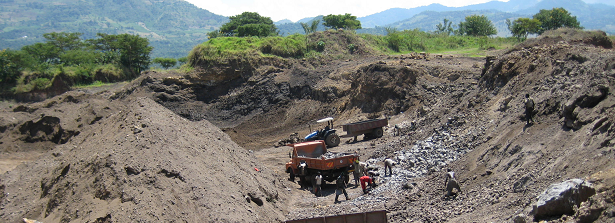Rock prospecting in Kenya

In both project sites of the Women Food Entrepreneurs GCP-2 project – Kisumu in Kenya and Ouagadougou in Burkina Faso – geochemical surveys were required to find rocks suitable for producing powder for soil conditioning. The Kisumu survey was carried out in the period August 30 to September 7 2016 by Prof JB Okeyo-Owuor, Gilbert Modi and Huig Bergsma.
Given that transport of the rocks should be kept to a minimum, the survey was concentrated in a zone 100km around the city of Kisumu. A total of two larger mechanized quarries (KCP/Ndugu, Homa Lime) were visited, as well as six smaller active or deserted artisanal quarries (Lake Quarry, Raroki, Samanga, Adhiambo, Got Okii, Kedowa). Several additional rock samples were taken along the roadsides to get an impression of the potential of the surrounding area (Fort Ternan, Chepseon, Londiani).
Samples were analysed using a Niton Goldd+ Portable XRF, with potassium and calcium used to discriminate potential useful rocks from less useful rocks. The big advantage of using the XRF was that in a short period a good overview of the rock chemistry in the area was obtained, without first taking small samples home for analysis and then deciding which rock to use for experimental work. Instead, the selection of rocks was already carried out in Kenya and samples for pot experiments totalling 22kg were taken to the Netherlands.
Most of the rocks found in the Kisumu area were sodium-rich phonolites, which may have a fairly good liming effect although they are poor in nutrients. (Phonolites are volcanic rocks which produce a distinctive chime like sound when hit with a hammer, hence the name.) However, potentially useful rocks were found and sampled south east from Homa Hill, near a small place called Raroki and near the limestone quarry at Legetet Hill. These rocks are rich in potassium, calcium and magnesium and, particularly the rocks from Legetet Hill, are also rich in micronutrients like copper, zinc and cobalt. Since the suitable rocks were found in an artisanal quarry and a limestone quarry respectively, it will pose a challenge to produce enough volume at the right quality for our planned field trials.
Besides large mechanized quarries, a considerable part of the gravel is produced in small artisanal quarries under harsh conditions, where women reduce cobbles to coarse gravel, sometimes using very primitive tools. On behalf of the project consortium, four bench hammers were donated to the women of the Adhiambo quarry.
Please download the Geological Survey Kisumu (PDF).






